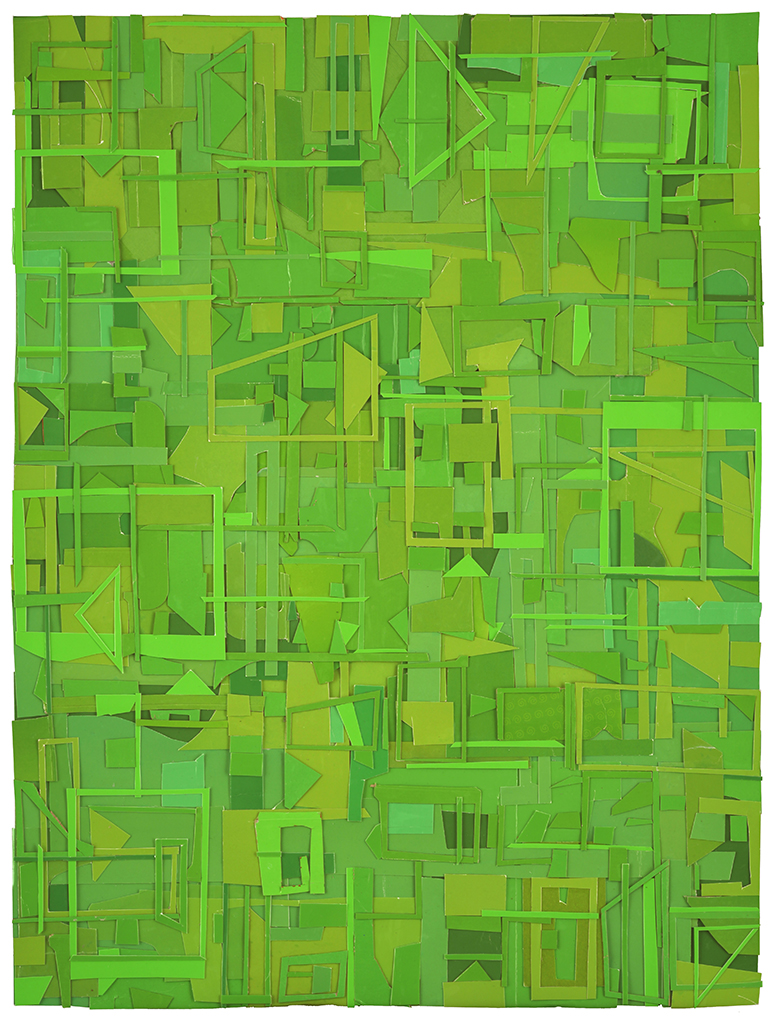by Gwynned Vitello
As a public defender, Matt Gonzalez does just that, using legal expertise to represent those in the city and county who are without resources. Behind plea bargains and the filing of papers are families, neighbors, and strangers who sometimes arrive at fateful intersections, both literal and physical, in the streets of San Francisco. The same streets where Gonzalez mines the material for his art. Walking into a gallery of his collage work is like entering a room full of reflecting stained glass. Each piece stands on its own, though collectively, the effect is a stunning homage to color and light, texture and association. The artist and lawyer is one, seeking stories, making connections and, if you will, framing the evidence. We asked him a few questions about his newest work, Derivations in Color at the Dolby Chadwick Gallery which shows October 4 through 27, 2018.
Matt Gonzalez | After the autumn-waiver, flowersome, 2018 | Found paper collage | 24 x 18 inches
Gwynned Vitello: How long does it take to make a collage, and do you work on several at a time? Matt Gonzalez: Some of the larger pieces (18x24 inches) can take 15-20 hours, not including the time to gather the materials, which are all found materials.
I work on multiple pieces at a time, only because I maintain two studios (one at 7th & Folsom, the other in my apartment near Alamo Sq. Park). Otherwise, I prefer to work on a single piece until it’s completed.
Do you have favorite materials, or do you like the challenge of working with something new? I’ve been working with found paper materials, often picked up on the street or sidewalk. The environmental distress is apparent on the surface, which can’t be replicated or faked in the studio. Sunlight, rain, car tires, etc, all do something to the paper which I’m attracted to.
I’ve worked with wood also (mostly during 2012), but I found it to be a slower process. Paper allows an immediacy that appeals to me. I can place 100 pieces into a collage, whereas when I work with wood, 4 or 5 pieces would be the most I place into the artwork before wanting to contemplate the direction the piece is going in.
What is the first art you made, and how did collage become your favorite medium? I started experimenting with painting in 2005. I did mostly geometric abstraction, some figurative pieces, and instinctively moved into collaging with shards of cut-up paintings and found paper materials. The painting started as a way for me to have a better knowledge of looking at art, meaning I wanted to be better informed when I looked at a painting, by virtue of having experienced moving paint around a surface with a brush or palette knife. I’m not sure why I moved to including found discarded paper. I’ve always loved Kurt Schwitters’ work, so it must have been implicit. Also, seeing bright colors or interesting paper design discarded on the city streets during my walks, probably inspired the expansion of the palette away from bought paints to something that conveyed an urban and very contemporary moment.
I have to say I like the intimacy of paper. I don’t need a lot of space to work. Each piece has my DNA on it. I’ve touched every piece that makes it into a collage, in that way it’s very personal and is connected to me in the way a painting can’t be (by virtue of the distance between a painting and the painter holding a brush).
I imagine you working late into the evening, but you DO have a daytime job. Where and when do you work, and given the emotional demands of your work, does art-making function as an outlet? I work in a studio at 7th and Folsom (near the Hall of Justice) and also a studio in my home. During the typical work week, I will work first thing in the morning as I drink my coffee and after I’m home from working as a lawyer in the evening. I live alone, don’t have a television, and so am able to focus on the artwork whenever inspiration hits me. I can also go to the studio during my lunch break if I have something I’m just dying to keep working on. The breaks improve the work, I think. Having fresh eyes to see where a piece is going is something I’m lucky to naturally have (by virtue of the demands of my lawyer job). It would be hard to otherwise have the discipline to leave it alone and breathe, as opposed to just pushing it to a conclusion.
During a typical weekend, I’ll easily put in 4 to 5 hours on a Saturday and Sunday (each day) in my apartment studio.
I should say that because some of the works are monochromatic, I need natural light when I’m finishing a piece, to make certain the colors are just the way I want them.
I do find the art-making reaffirming. It’s healthy to put all of my mental attention toward making the art. Like gardening, my mind is primarily focused on the endeavor, although I have been known to suddenly want to write down an idea I have on a case I’m working on, even though I didn’t consciously intend to think about anything other than the art task at hand. In some ways, it’s like doing a puzzle or playing a game of chess. Your mind is so focused on a task, that everything else, while present, recedes to the background. In that way, it gives you a break from routine or other considerations.

